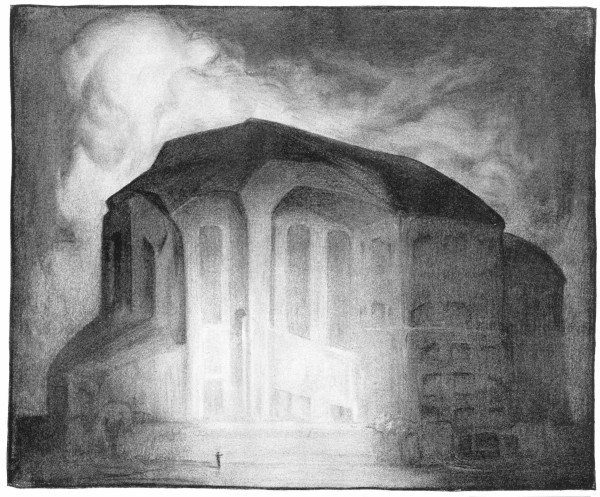The Second Goetheanum
GA 36
Translator Unknown
The following article, translated from the Basler Nachrichten of Nov. 3rd, 1924, is Dr. Steiner's own account of the new building. With the December number of Anthroposophy the reproduction of a drawing by Arild Rosenkrantz interpreting Dr. Steiner's design for the new Goetheanum will be presented to our subscribers.—Editor (see drawing at the end)
The rebuilding of the Goetheanum has been the subject of much discussion in the Press and has aroused interest in the widest circles. We are now in a position to publish a picture of what the future building will be like and have also approached Dr. Rudolf Steiner, asking him to give us the thought which underlies the building.
To rebuild the Goetheanum in conformity with the underlying thought of its purpose is no easy task. An entire change of outlook was necessary because the old building was constructed principally of wood and the new one is to be entirely of concrete.
It has to be borne in mind that there must be no contradiction between the form of the building which is to be devoted to the cultivation of Anthroposophy and the nature of Anthroposophy itself. Its creation must come from the spiritual sources from whence flows spiritual knowledge for the intellect but from whence flows also art forms and style for the imagination that has sensibility. It strives for the primval origins of knowledge but also for artistic form in style and proportions. It would be absurd for anyone to build the working centre for Anthroposophy who, with any kind of artistic perception, looked upon the nature of Anthroposophy from a merely external standpoint. This working centre can only be built by one who experiences every detail of its form from a spiritual, artistic outlook; the same outlook through which he experiences with understanding every word that is spoken out of Anthroposophy.
By reason of the softness of wood it was possible to build a Hall in that material in such a way that one could strive to imitate the creating of organic forms in Nature. The organic character of the whole building made it necessary that even the smallest part in the structure could not be different; just as in Nature, no detail—say for instance the lobe of the human ear—could possibly be constructed otherwise.
Starting from the artistic realization of this organic creating of Nature, one is led to an 'organic' style of Architectural construction in contradistinction to one relying solely on what is static or dynamic—a style in which even what is of Nature is raised to what is of Spirit through creative fancy. Thus, for instance, in the lobby of the old Goetheanum which visitors entered before attaining the great auditorium, it was possible to make a structure where the forms in the wood clearly denoted: 'the auditorium is ready for those outside to enter.'
But the peculiarities of special forms were quite over-ruled by each part being incorporated and made one with the whole building. The same thing could be observed in the outward form of the building. Here was revealed through art all that was constructed and embraced for the object of Anthroposophical work.
This way of building from constructive thoughts cannot be carried out in concrete as in wood. For this reason it has taken nearly a whole year to construct the new model. When building in wood one works forms and spaces into the wood; by carving out surfaces, shapes arise. The opposite is the case with concrete, a material from which shapes arise through raising surfaces within the limits of the necessary space. This applies also to the building of forms which tend outwards. Surfaces, lines, angles and so on, must be placed so that what is formed within presses out into the outward forms and thus expresses itself.
Besides all this it was necessary to construct the second Goetheanum more economically with regard to space than the first which was in reality but one single Hall and was built so that it made a frame for both lectures and performances. Now however we must have two stories, a lower one for work and lectures, with a stage for auditions; and an upper one, the auditorium and stage which can also be used for lectures.
This inner arrangement had to follow the architectural lines and surfaces which tend outwards. This can be seen in the shape of the roof which this time will not be a cupola. Anyone with a feeling for form will realize how it has been attempted to solve the difficulty of making the roof on one hand artistic and in conformity with the rake of the auditorium and on the other hand to enclose the stage with its tore rooms. Perhaps a way will be found through unprejudiced, artist's consideration to carry out the architecture in accord with the necessities of its outline and connect all with the forms of the west front which we have already ventured to give.
The building will stand upon a terrace. Thus it will be possible to walk round the building on a level raised above the ground. Wide steps will lead from the ground to the terrace and thus to the Portal. Under the terrace there will be the cloak rooms.
The designer of the building is convinced that the shape of the hills upon one of which the Goetheanum will stand, will be in keeping with the structure of this concrete building. When he made the wooden building he was not yet at home with these nature forms as he is now when he can look back over a decade during which time he has learnt to know and to love them. He can create the building out of their own spirit, and in a way quite different to that which was possible eleven years ago.


